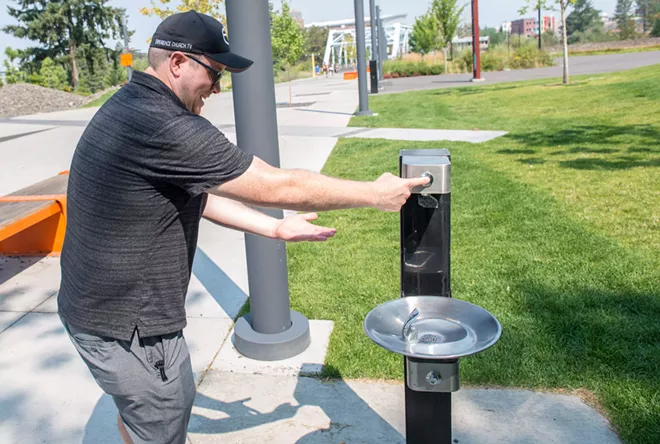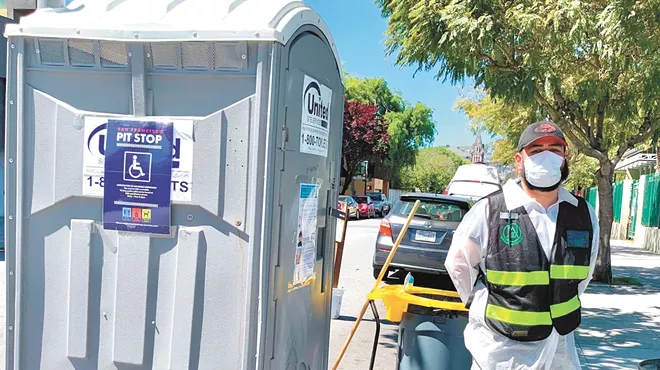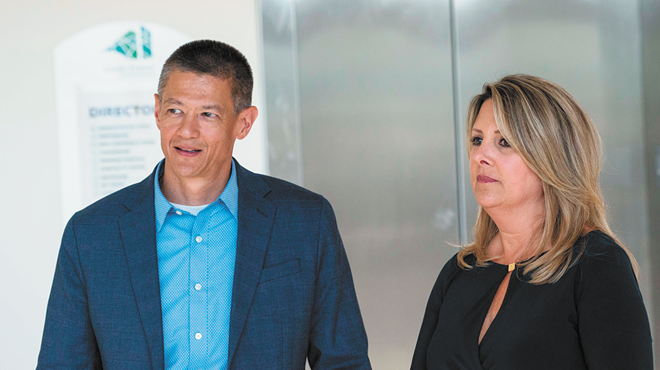
Daniel Walters photo
Out-of-town visitor Sam Warren showcases the inoperability of one of Riverfront Park's relatively new water fountains on Friday morning.
T
hey don't have parks like these on the West Side, Sam Warren, an IT consultant from Puyallup, is thinking as he strolls down Riverfront Park's promenade Friday morning.He heads over to the water fountain — still nearly new, glimmering in the midday sun — sticks his plastic water bottle under the water-bottle tap and hits the button. Nothing comes out. He tries the other button. That one doesn't work either.
"It's like, 'Guys, we're in the middle of a heat wave,'" he says. "102 today, 104 tomorrow."
And this, perhaps, is another quintessential part of the Spokane parks experience: the thirsty surge of anticipation upon finding a drinking fountain at a park, thoughts of ice-cold relief dancing through your head, then dreams dashed by a broken fountain.
I've had that experience: At the last mile at the end of a grueling 30-mile bike ride, handicapped with underinflated tires and an out-of-shape body, I staggered to the Fish Lake trailhead fountain like a Far Side character dragging himself to a desert oasis. Then I hit that nonworking fountain button and learned that oasis was nothing more than a mirage.
But by now, Dickson says, "we have all working fountains turned on."
"Working" is the big caveat. Right now, a lot of the drinking fountains are busted.
"We always have damage to water fountains in the winter, but we're seeing more damage to water fountains this year," Dickson says. Some of that's from vandalism; some of it's just from worn-out drinking fountain infrastructure.
The drinking fountains in Riverfront were designed to avoid the kinds of damage that could come from the winter freeze cycle, but they aren't working anyway.
"ATTENTION: This is a freeze-proof drinking fountain and has a delayed water action," stickers on the fountains say. "Press button and wait. Thank you."
You can press the button. But you may be waiting a very long time.
Dickson didn't immediately know what the issue was with the Riverfront fountains, but she says their bigger problem was that they don't have the staff to address all of the maintenance needs in the parks right now.
I've had that experience: At the last mile at the end of a grueling 30-mile bike ride, handicapped with underinflated tires and an out-of-shape body, I staggered to the Fish Lake trailhead fountain like a Far Side character dragging himself to a desert oasis. Then I hit that nonworking fountain button and learned that oasis was nothing more than a mirage.
“I had it at Manito the other day, too,” says Spokane parks department spokeswoman Fianna Dickson. “I get it.”
During much of the COVID pandemic, most of the drinking fountains were turned off, Dickson says, because they didn't have enough staff to clean them.
Last week, the Inlander's Nate Sanford wrote a piece about the latest efforts to try to open more public bathrooms. But access to water is just as vital a human need. Studies have shown just how challenging it is for homeless people to access drinking water — and during heat waves, that lack of access can be fatal.
But by now, Dickson says, "we have all working fountains turned on."
"Working" is the big caveat. Right now, a lot of the drinking fountains are busted.
"We always have damage to water fountains in the winter, but we're seeing more damage to water fountains this year," Dickson says. Some of that's from vandalism; some of it's just from worn-out drinking fountain infrastructure.
The drinking fountains in Riverfront were designed to avoid the kinds of damage that could come from the winter freeze cycle, but they aren't working anyway.
"ATTENTION: This is a freeze-proof drinking fountain and has a delayed water action," stickers on the fountains say. "Press button and wait. Thank you."
You can press the button. But you may be waiting a very long time.
Dickson didn't immediately know what the issue was with the Riverfront fountains, but she says their bigger problem was that they don't have the staff to address all of the maintenance needs in the parks right now.
"We have a major labor shortage," Dickson says. "We can hardly finally find enough people to have to do our core services in parks. Which is why only about half of our permanent restrooms are open right now. We can just not find enough people to go around and clean those restrooms."
During the pandemic, the parks department had a partial hiring freeze that barred the department from hiring most temporary or season workers due to fears that depressed tax revenue would lead to big budget deficits. That hiring freeze was lifted in June, but like a lot of employers lately, the city has had a hard time finding people who want to work there — or stay working there.
"We just can hardly get enough people to apply," Dickson says. "That's the biggest issue. Once we do get some staff — a little bit; we've never been fully staffed this year — we've had some turnover."
Right now the parks department only has about half of its temporary or seasonal positions filled, Dickson says. Browse through the list of open part-time or seasonal positions and you'll see the department is looking for a facilities custodian, a golf course maintenance worker, a grounds caretaker, an irrigation laborer, an event maintenance team member, sports facilities grounds-keeping and maintenance crew members, and a grounds and operation specialist.
And that's not the only problem. They're also having difficulty getting the stuff they need to fix some of the fountains.
"Once we do have enough staff, we're facing part shortages," Dickson says. "Some of them are just difficult to come by."
Worldwide getting almost anything has been complicated by massive logjams associated with the impacts of the pandemic.
Problems include a shortage of storage space, skyrocketing need for raw materials, housing construction demand, temporarily-closed factories, and the way the entire global supply chain — intended to deliver only exactly what customers needed exactly when they needed it — was thrown wildly off-kilter by the pandemic.
And these are the sorts of factors that can merge together and trickle down to parks in Spokane, where many drinking fountains don't trickle at all.


